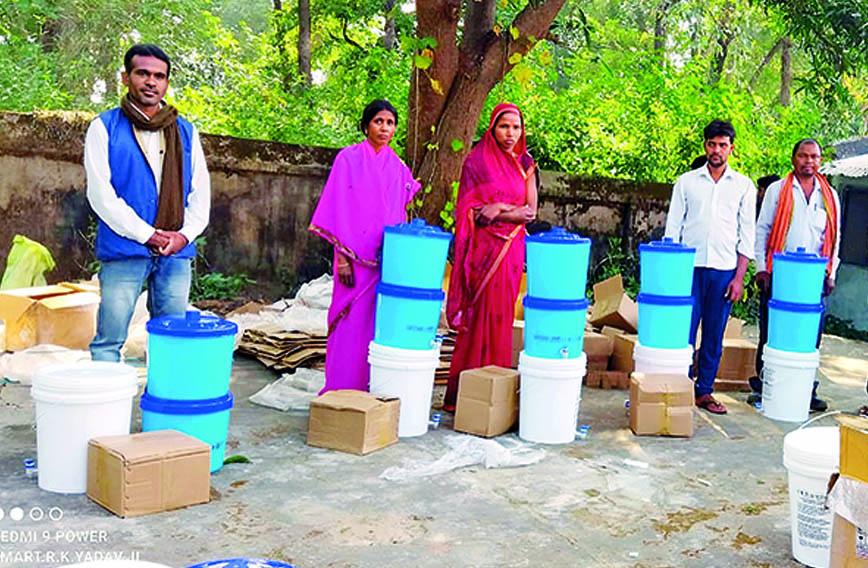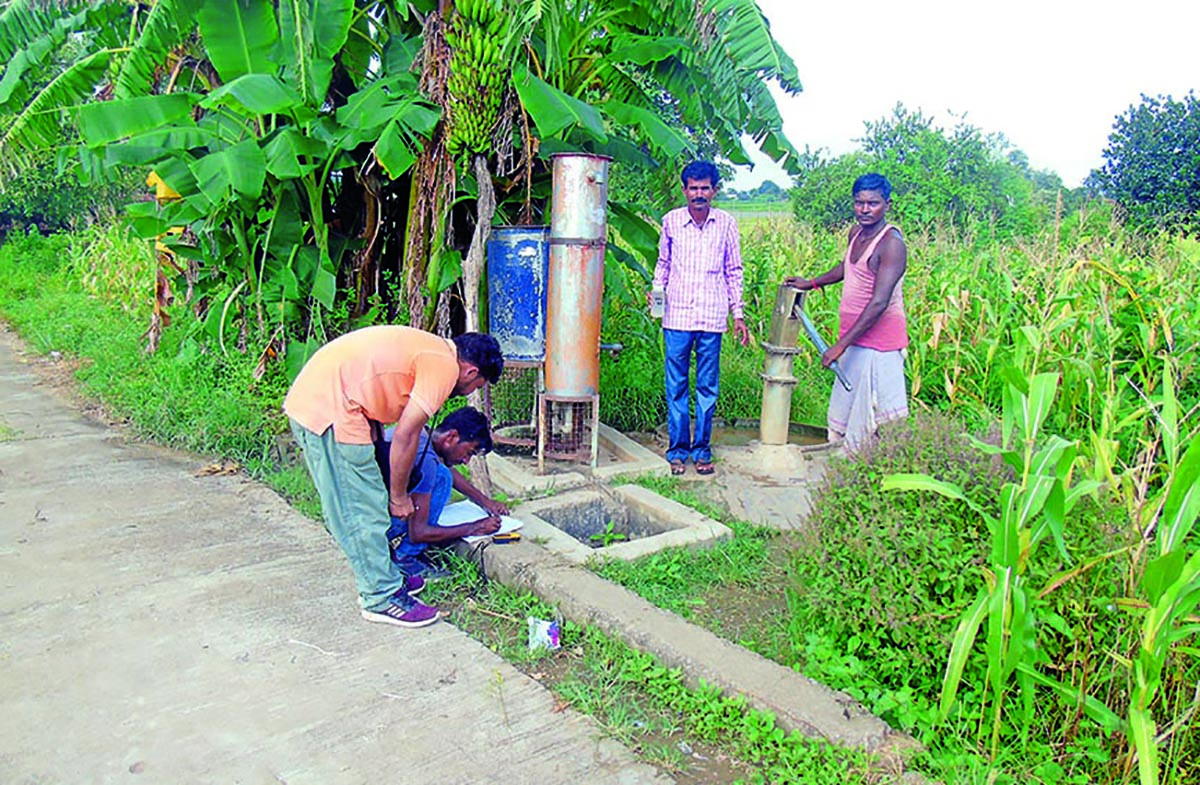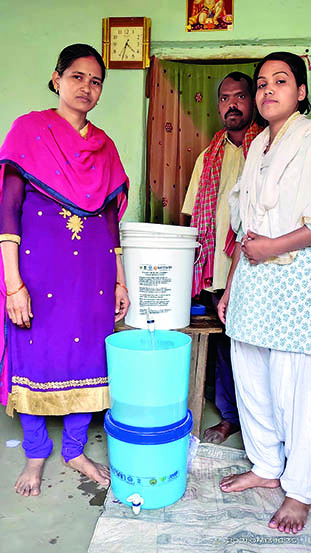
The filter converts fluoride-laced water into potable water in six hours
Filter offers hope against fluorosis
Rakesh Agrawal, Dehradun
Afilter invented by the People’s Science Institute (PSI), a voluntary organization in Dehradun, is combating fluorosis, a degenerative disease caused by drinking water laced with excessive fluoride. A two-year experiment found that the filter, along with better nutrition and awareness, reversed the ill effects of fluorosis in villages battling the disease for decades in Sonbhadra district of Uttar Pradesh (UP).
The district is hemmed in by four states — Madhya Pradesh, Chhattisgarh, Jharkhand and Bihar — and jammed between the hills of Kaimur and Vidhyan. Dubbed the energy capital of India, Sonbhadra is one of the country’s most critically polluted districts.
Why? Because, first of all, it has huge thermal power plants spewing pollutants. The power plants have a total installed capacity exceeding 21,000 MW. They burn three lakh tonnes of coal every day, releasing 30,000 kg of fluoride into the environment.
Then there are aluminium smelting industries, which too discharge fluoride as part of the production process. Nature hasn’t been kind to Sonbhadra either. Underlying granite rocks in the region release fluoride, a geogenic occurrence.
All this fluoride has converted Sonbhadra’s villages into a toxic hell, seeping into groundwater and the atmosphere. The presence of excessive fluoride in water causes a deadly disease, fluorosis, and its cousin, dental fluorosis. It results in bent and fractured teeth, tooth discolouration and skeletal fluorosis, affecting bones and joints and resulting in debilitating pain, stiffness and bone deformities.
The people of the district are mostly marginal farmers who own about two to four bighas (about 0.5 to 1 ha) of infertile plateau land, with practically no irrigation apart from scanty rainfall. They have no choice but to resort to casual wage labour in the same thermal and aluminium plants that pollute their environment. Fear of losing their meagre livelihood haunts them.
“Our partner organization, the Banwasi Seva Ashram (BSA), had been lobbying with the government for years to find a solution to the problem of fluorosis. Since they did not have the technical knowledge to deal with this issue they approached us in 2020. We developed filters in a few months that make the water safe and potable in six hours,” says Dr Anil Gautam of PSI.
The villagers did file a case with the National Green Tribunal (NGT) which acknowledged the fluorosis menace in Sonbhadra. In its judgment, the NGT ordered the setting up of a hospital in the region and training of local doctors so that they could identify cases of fluorosis at an early stage and begin treatment before the disease progressed. Medical supplements for residents was also part of the court’s order.
So far the NGT order has not been implemented.
 Groundwater being tested in Sonbhadra district
Groundwater being tested in Sonbhadra district
“People also pressured the thermal power plants who then installed a few RO plants. But they are insufficient for the district. They don’t cover all villages in the most affected blocks of Dudhi, Myorpur and Chopan,” says Prem Narayan of the PSI.
The PSI has set up a well-equipped lab in Govindpur village. “Water is thoroughly checked at the lab, both at pre- and post-filtering stage, along with TDS, bacteria and fluoride content. We have found that the filtered water is potable,” says Dr Gautam.
Residents of two villages, Kushmaha and Govindpur, located close to BSA, were initially selected to test the efficacy of the filter. Multiple cases of dental and skeletal fluorosis had been identified in the two villages.
 |
|
A simple and effective device |
The project was carried out between September 2020 and October 2022 during the COVID-19 pandemic. Nationally, infections peaked around September 2020 and then started reducing. Previous monitoring by BSA found 1-3 ng/m3 of fluoride in the atmosphere. It was found that the groundwater in Kushmaha and Govindpur contained fluoride between 0.6-7.26 mg/l and 0.8-6.76 mg/l, respectively, whereas the acceptable limit, according to the World Health Organization and the Bureau of Indian Standards, should be between 1-1.5 mg/l, meaning 1-1.5 parts per million.
Residents of villages across the district are affected by fluorosis. About 97.11 percent of Kushmaha’s residents and 88.65 percent of Govindpur’s residents had fluoride levels above 1.5 mg/l. Only 0.61 percent of residents in both villages showed no signs of dental fluorosis. Around 1.72 percent of residents also showed no signs of skeletal fluorosis. Mild, medium or serious symptoms of dental and skeletal fluorosis, respectively, were seen in 77.06 percent and 78.62 percent of residents.
Although more than two lakh people of 276 villages of Sonbhadra district are affected by drinking fluoride-contaminated water, a pilot project just in the two villages was taken up, as they were situated close to the BSA premises.
The purpose of the pilot project was to establish a model for fluorosis mitigation. Various interventions such as providing de-fluoridated water, nutritional and medical supplements, as well as encouraging villagers to consume a nutritious diet, were carried out.
The PSI and BSA had to interact regularly with villagers to ensure they followed these practices, and to observe the impact of their interactions.
“We also had to exert pressure to ensure that the region wasn’t further polluted. That would have undone the impact of our fluoride mitigation efforts. It would have also caused the remaining sources of water to become contaminated with high levels of fluoride as well,” says Dr Vibha Augustine of the BSA.
Initially, the BSA and the PSI jointly carried out a survey and monitored the health of 100 individuals, 70 from Kushmaha and 30 from Govindpur. These were residents who were still dependent on drinking water that had higher than permissible levels of fluoride, showed symptoms of dental or skeletal fluorosis, and had increased levels of urinary fluoride. Medical tests were carried out in January and February 2021. Blood samples were collected and tested for red blood cells, haemoglobin, and erythrocyte sedimentation rate (ESR), uric acid and serum calcium levels.
On the basis of the medical test data, nutritional supplements were given. Some participants were checked again in August 2021 for serum calcium levels. People exposed to high levels of fluoride were found to have lower levels of serum calcium. In January-February 2022, levels of serum calcium were found to have improved from earlier August levels.
One reason could be the availability and consumption of green leafy vegetables and sesame seeds in the colder months as compared to summer. These are high in calcium and thus people have better levels of serum calcium. The festival of Makar Sankranti which falls in January is associated with the consumption of large amounts of sesame (til) laddu.
Out of 100 individuals, the plan was to closely monitor 94 individuals. Six people were monitored in controlled conditions. However, only 74 kits were installed as 20 households refused to accept the filter, fearing a social backlash.
“Although in 2020 the cost of one fluoride filter was `3,500, people got it free since PSI, the supporting agency, bore the cost. They were happy to have it in their homes,” says Narayan.
“We don’t have to worry about having to raise money for treatment of our deformed bones. We also save time, since we don’t have to walk miles to collect water from a distant well,” says Chameli Devi, 55, an Adivasi.
Additionally, residents were given nutritional supplements in the form of sesame and methi mahua laddus. People were encouraged to raise nutrition gardens on their farms and grow green leafy vegetables for consumption to fight the impacts of drinking fluoridated water.
After using the filter, villages are reporting a regression of fluorosis and improved health.
Forty-year-old Chameli Devi of Govindpur, a small village of 110 households, was suffering from knee joint osteopenic and patellar erosion caused by the deposition of fluoride in soft tissues. She started using the PSI filter in 2020. Two years later an X-ray of her knee showed her knee joints were in the normal range.
”We have this wonderful filter in my house,” she said. “It filters the toxic water into safe drinking water. We’re using it since 2020. I can now stand and walk normally. I will soon rejoin my work as a fitter in the nearby aluminium factory.”
Fifty-year-old Chedi Ram of Kushmaha, which is a bigger village of 250 households, was suffering from severe knee joint pain and deformities in his femur and tibia. The tibial head had eroded since deposition of fluoride in soft tissues had taken place.
He started drinking fluoride-free water in 2020. By 2022, sclerosis of the distal end of the femur and tibia improved, resulting in improvement of his bone density. “Now, I can go to my three-bigha (about 0.75 ha) land and take care of my crops,” he says.
To make people aware of the dangers of drinking water laced with fluoride and to encourage them to use the filter, BSA and PSI jointly carry out awareness campaigns. But they have found it tough. “The much publicized Har Ghar Nal, Har Ghar Jal Yojna is supposed to materialize this year. It will flood the people with fluoride-laced groundwater through wells, borewells and tubewells,” says Narayan.
The two organizations took out a Sandesh Yatra. In September 2023, a rally was organized to inform people about the dangers of fluorosis. A presentation too was drawn up. Students and teachers of village schools, a heath team and villagers participated. Many flip cards and handbills were exhibited with messages related to fluoride mitigation. A meeting, organized with all participants, was well covered by local vernacular newspapers like Aaj, Hindustan, Dainik Jagran and Amar Ujala.
“Earlier I could not grow anything on my parched land. Now I am growing leafy vegetables in my backyard. My knee joints are perfectly normal now,” says Ramashankar, 52, a Dalit farmer from Kushmaha village.
In the International Year of Water, this is a significant step towards providing safe, secure and potable water.
Comments
Currently there are no Comments. Be first to write a comment!





